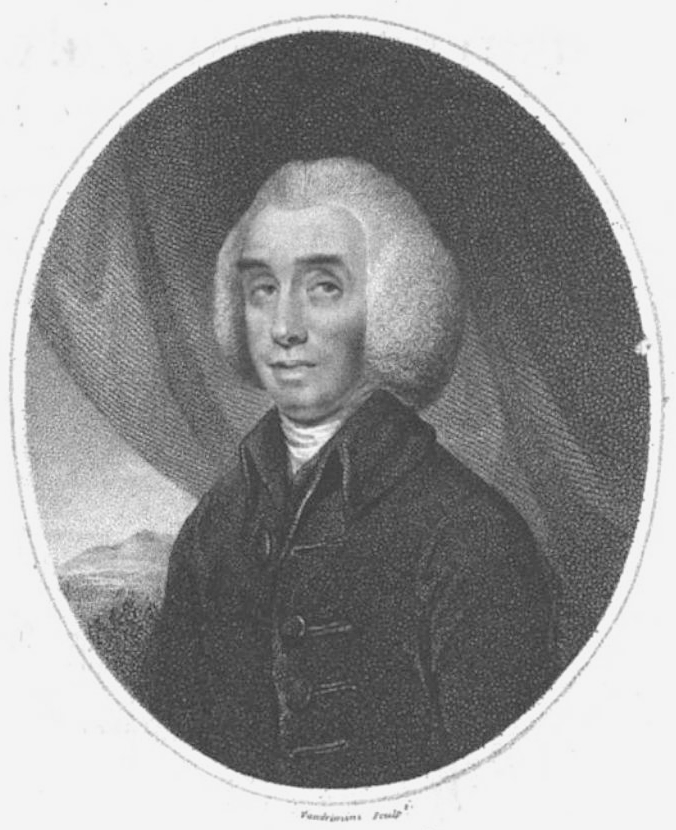
Theophilus Lindsey
Theophilus Lindsey (20 June 1723 O.S. – 3 November 1808) was an English theologian and clergyman who founded the first avowedly Unitarian congregation in the country, at Essex Street Chapel. Lindsey's 1774 revised prayer book based on Samuel Clarke's alterations to the 1662 Book of Common Prayer inspired over a dozen similar revisions in the succeeding decades, including the prayer book still used by the United States' first Unitarian congregation at King's Chapel, Boston.
Early life[edit]
Lindsey was born in Middlewich, Cheshire, the son of Robert Lindsey, a mercer, and godson of Theophilus Hastings, 9th Earl of Huntingdon, for whose mother his mother had been a servant.[1][2] He was educated at the Leeds Free School and at St John's College, University of Cambridge, where in 1747 he became a fellow.[3]
Ordained deacon in 1746 and priest in 1747, Lindsey's church career advanced by aristocratic patronage. For some time he was a curate in Spitalfields, London, a position found for him by Lady Ann Hastings, aunt to the 9th Earl.[1] The nomination was by Granville Wheler, Lady Ann's brother-in-law.[4]
Lindsey was domestic chaplain to Algernon Seymour, 7th Duke of Somerset, who died in 1750. Then he was employed as tutor to the Duke's young grandson, Lord Warkworth—Hugh Percy, originally Hugh Smithson, the future 2nd Duke of Northumberland—from 1751 to 1753 travelling on the continent of Europe.[1] Warkworth was destined for Eton College, and Lindsey turned down the post of accompanying him there which went to Charles Dodgson.[5]
Parish priest[edit]
Lindsey was then presented to the living of Kirkby Wiske in Yorkshire, by Hugh Percy, 1st Duke of Northumberland.[6] He was present there in 1753–4.[7]
After exchanging it for that of Piddletown in Dorset, in the gift of Francis Hastings, 10th Earl of Huntingdon, he rejected a chance to go to Dublin with the Duke of Northumberland, who became Lord Lieutenant of Ireland in 1762.[1] At Piddleton he came to know Thomas Hollis of Corscombe, and through him William Harris, both dissenters.[8] In 1760, he married Hannah Elsworth, step-daughter of Francis Blackburne, whom he had known since his time at Kirby Wiske.[9]
The Feathers Tavern Petition[edit]
In 1771 Lindsey joined with Blackburne, John Jebb (1736–1786), Christopher Wyvill (1740–1822) and Edmund Law (1703–1787), bishop of Carlisle, in preparing a petition to Parliament. This petition, now called the Feathers Tavern Petition, prayed that clergymen of the Church of England and graduates of the universities might be relieved from the burden of subscribing to the Thirty-Nine Articles, and "restored to their undoubted rights as Protestants of interpreting Scripture for themselves".[16][18]
Two hundred and fifty signatures were obtained, but in February 1772 the House of Commons declined even to receive the petition by a majority of 217 to 71; the adverse vote was repeated in the following year. At the end of 1773, Lindsey resigned as vicar of the Church of England.[16] He became instead a leading Unitarian.[18]
Lindsey's major work was An Historical View of the State of the Unitarian Doctrine and Worship from the Reformation to our own Times (1783).[29] It was written in response to the Plea for the Divinity of Christ of the Baptist minister Robert Robinson.[18] There was a 1785 reply to it, arguing against Lindsey's use of Abraham Tucker's views on the Trinity, by Thomas Kynaston as "A Layman", on behalf of Tucker's daughter.[30] Lindsey's other publications included:
Two volumes of sermons, with prayers annexed, were published posthumously in 1810.[16]
Thomas Belsham's Memoirs of the Late Reverend Theophilus Lindsey, M.A., including a brief analysis of his works; together with anecdotes and letters of eminent persons, his friends and correspondents; also a general view of the progress of the Unitarian doctrine in England and America appeared in 1812.